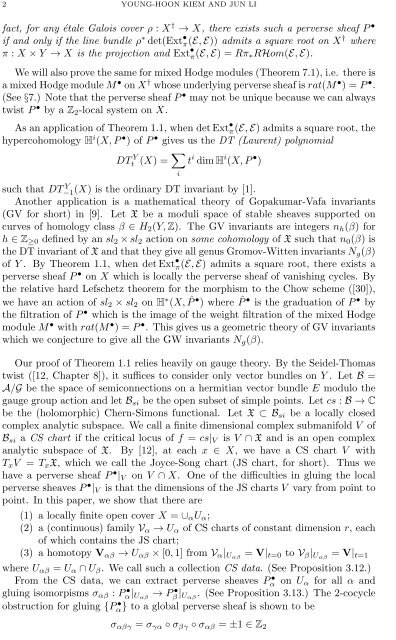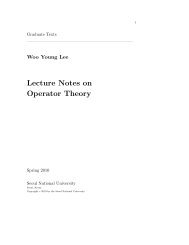Categorification of Donaldson-Thomas invariants via perverse ...
Categorification of Donaldson-Thomas invariants via perverse ...
Categorification of Donaldson-Thomas invariants via perverse ...
You also want an ePaper? Increase the reach of your titles
YUMPU automatically turns print PDFs into web optimized ePapers that Google loves.
2 YOUNG-HOON KIEM AND JUN LIfact, for any étale Galois cover ρ : X † → X, there exists such a <strong>perverse</strong> sheaf P •if and only if the line bundle ρ ∗ det(Ext • π(E, E)) admits a square root on X † whereπ : X × Y → X is the projection and Ext • π(E, E) = Rπ ∗ RHom(E, E).We will also prove the same for mixed Hodge modules (Theorem 7.1), i.e. there isa mixed Hodge module M • on X † whose underlying <strong>perverse</strong> sheaf is rat(M • ) = P • .(See §7.) Note that the <strong>perverse</strong> sheaf P • may not be unique because we can alwaystwist P • by a Z 2 -local system on X.As an application <strong>of</strong> Theorem 1.1, when det Ext • π(E, E) admits a square root, thehypercohomology H i (X, P • ) <strong>of</strong> P • gives us the DT (Laurent) polynomialDT Y t(X) = ∑ it i dim H i (X, P • )such that DT−1(X) Y is the ordinary DT invariant by [1].Another application is a mathematical theory <strong>of</strong> Gopakumar-Vafa <strong>invariants</strong>(GV for short) in [9]. Let X be a moduli space <strong>of</strong> stable sheaves supported oncurves <strong>of</strong> homology class β ∈ H 2 (Y, Z). The GV <strong>invariants</strong> are integers n h (β) forh ∈ Z ≥0 defined by an sl 2 × sl 2 action on some cohomology <strong>of</strong> X such that n 0 (β) isthe DT invariant <strong>of</strong> X and that they give all genus Gromov-Witten <strong>invariants</strong> N g (β)<strong>of</strong> Y . By Theorem 1.1, when det Ext • π(E, E) admits a square root, there exists a<strong>perverse</strong> sheaf P • on X which is locally the <strong>perverse</strong> sheaf <strong>of</strong> vanishing cycles. Bythe relative hard Lefschetz theorem for the morphism to the Chow scheme ([30]),we have an action <strong>of</strong> sl 2 × sl 2 on H ∗ (X, ˆP • ) where ˆP • is the graduation <strong>of</strong> P • bythe filtration <strong>of</strong> P • which is the image <strong>of</strong> the weight filtration <strong>of</strong> the mixed Hodgemodule M • with rat(M • ) = P • . This gives us a geometric theory <strong>of</strong> GV <strong>invariants</strong>which we conjecture to give all the GW <strong>invariants</strong> N g (β).Our pro<strong>of</strong> <strong>of</strong> Theorem 1.1 relies heavily on gauge theory. By the Seidel-<strong>Thomas</strong>twist ([12, Chapter 8]), it suffices to consider only vector bundles on Y . Let B =A/G be the space <strong>of</strong> semiconnections on a hermitian vector bundle E modulo thegauge group action and let B si be the open subset <strong>of</strong> simple points. Let cs : B → Cbe the (holomorphic) Chern-Simons functional. Let X ⊂ B si be a locally closedcomplex analytic subspace. We call a finite dimensional complex submanifold V <strong>of</strong>B si a CS chart if the critical locus <strong>of</strong> f = cs| V is V ∩ X and is an open complexanalytic subspace <strong>of</strong> X. By [12], at each x ∈ X, we have a CS chart V withT x V = T x X, which we call the Joyce-Song chart (JS chart, for short). Thus wehave a <strong>perverse</strong> sheaf P • | V on V ∩ X. One <strong>of</strong> the difficulties in gluing the local<strong>perverse</strong> sheaves P • | V is that the dimensions <strong>of</strong> the JS charts V vary from point topoint. In this paper, we show that there are(1) a locally finite open cover X = ∪ α U α ;(2) a (continuous) family V α → U α <strong>of</strong> CS charts <strong>of</strong> constant dimension r, each<strong>of</strong> which contains the JS chart;(3) a homotopy V αβ → U αβ × [0, 1] from V α | Uαβ = V| t=0 to V β | Uαβ = V| t=1where U αβ = U α ∩ U β . We call such a collection CS data. (See Proposition 3.12.)From the CS data, we can extract <strong>perverse</strong> sheaves P α• on U α for all α andgluing isomorpisms σ αβ : P α| • Uαβ → Pβ • | U αβ. (See Proposition 3.13.) The 2-cocycleobstruction for gluing {P α} • to a global <strong>perverse</strong> sheaf is shown to beσ αβγ = σ γα ◦ σ βγ ◦ σ αβ = ±1 ∈ Z 2













